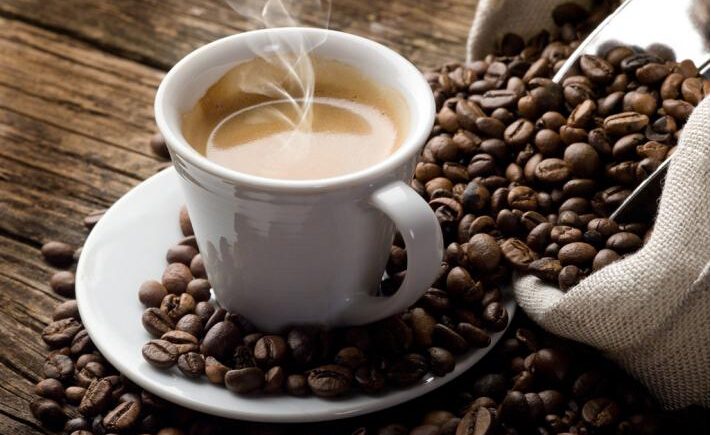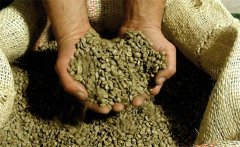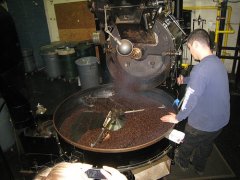Roasting skills play an important role in coffee flavor.
I believe many people know that the flavor of coffee is affected by roasting. But there are many factors that affect baking, such as climate, humidity, hardness and water content of raw beans. Because there are so many variables, baking experience is the most important key!

Before roasting, raw coffee beans have a fishy smell, and after baking, they will emit a strong aroma. The roasting degree of coffee beans will also affect the flavor and caffeine content of coffee. The lighter the roast, the stronger the acidity and the higher the caffeine content. The deeper the baking, the lighter the sour taste, the more obvious the sweet and bitter taste, and the lower the caffeine content.
Baking process:
When raw beans are baked at more than 200 degrees Celsius, the moisture begins to evaporate, the volume expands and the weight decreases. The deeper the baking, the more weight loss.
Another phenomenon is that during roasting, coffee beans release carbon dioxide, and the roasted cooked beans will continue to exhaust within 30 days, which helps coffee beans keep fresh. This is because when releasing carbon dioxide, oxygen molecules are not easy to invade and destroy the flavor of coffee, so coffee beans will not oxidize. If the coffee beans are oxidized, the flavor will quickly deteriorate, so the coffee brewed with fresh coffee beans has a particularly good flavor.
Baking tips:
Secret 1: to achieve the highest caramelization-caramelization is an important factor affecting the flavor of coffee, as raw beans absorb a lot of heat when roasting, then there is the first 1st cracking, at this time, the sugar begins to be converted into carbon dioxide, water continues to evaporate, the aroma of coffee will gradually come out and form coffee oil. This pyrolysis reaction can last until the second explosion (2nd cracking), but when the second explosion is completed, the temperature of the bean should be lowered immediately and as soon as possible, so that the highest caramelization can be obtained.
Tip 2: minimum carbonization-some ingredients will also be carbonized during the baking process, forming a bad bitter substance, so when you finish the second explosion, stop heating and minimize carbonization at the same time.
Tip 3: pay attention to the sound changes-coffee beans burst twice during roasting, and the first burst is low, indicating that the starch begins to turn into caramel and the water evaporates with carbon dioxide. The second burst sound is more violent and sharp, this is the sound of coffee bean cell fiber fracture, at this time should immediately stop heating, and as soon as possible with cold air to lower the temperature of the bean. The time of the first explosion and the second explosion can be very different, so baking different beans, it is necessary to find out the most suitable baking conditions for this bean.
Tip 4: pay attention to the changes in color and taste-the color of coffee beans will change from green to light brown as it continues to heat up, and then a small amount of oil will show a bright dark brown. At this point, you can no longer bake, otherwise the coffee oil on the surface of the beans will dry and give off a lot of smoke and scorched smell.
Generally speaking, coffee roasting is a science, the age, density, hardness and moisture content of raw beans will affect the quality of roasted coffee; even the relative humidity and temperature on the day of roasting can not be ignored!
Important Notice :
前街咖啡 FrontStreet Coffee has moved to new addredd:
FrontStreet Coffee Address: 315,Donghua East Road,GuangZhou
Tel:020 38364473
- Prev

The strong aroma of Italian coffee comes from the exquisite roasting technology.
Coffee roasting is like magic, turning cyan beans into dark brown, fragrant coffee beans! So the roasting of coffee is the key factor to determine the quality of coffee! Specifically, during the coffee roasting process, the heat is slowly transferred to the beans. Under the action of high temperature, the chemicals contained in the coffee bean itself produce physical and chemical changes. Like protein and sugar.
- Next

What is coffee roasting? top 5 points for attention
If you grab a handful of coffee beans and leave, you probably don't know how to bake coffee. Now, it's not surprising to have a coffee roaster. Many boutique coffee shops have their own coffee roaster and their own coffee roaster, which makes coffee roasting technology develop and mature. Did you ever want to know what it is?
Related
- Beginners will see the "Coffee pull flower" guide!
- What is the difference between ice blog purified milk and ordinary milk coffee?
- Why is the Philippines the largest producer of crops in Liberia?
- For coffee extraction, should the fine powder be retained?
- How does extracted espresso fill pressed powder? How much strength does it take to press the powder?
- How to make jasmine cold extract coffee? Is the jasmine + latte good?
- Will this little toy really make the coffee taste better? How does Lily Drip affect coffee extraction?
- Will the action of slapping the filter cup also affect coffee extraction?
- What's the difference between powder-to-water ratio and powder-to-liquid ratio?
- What is the Ethiopian local species? What does it have to do with Heirloom native species?

